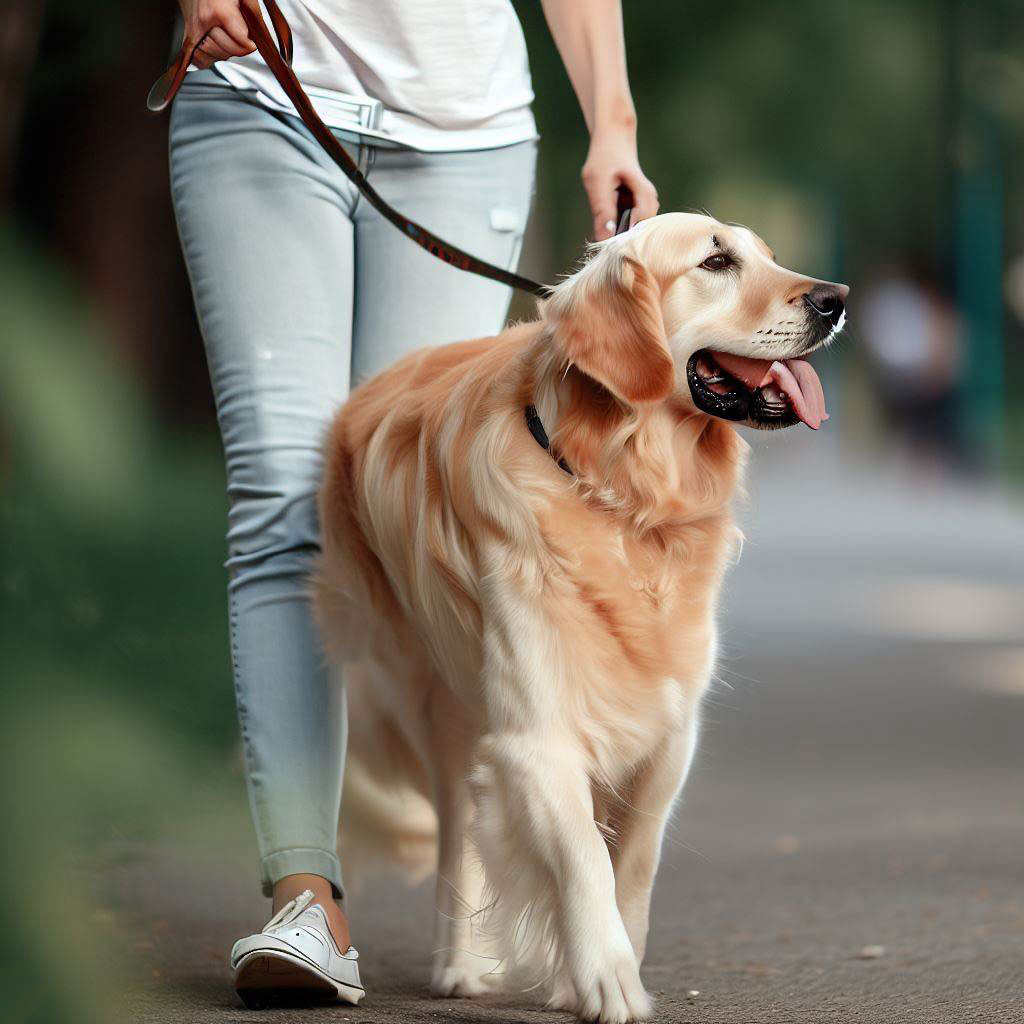How to Teach a Dog to Heel: An Authoritative Guide
Discover How to Teach a Dog to Heel: Beginner’s Guide to Dog Training. Uncover secrets to successful heel training every owner should know!
Table of Contents
Introduction
Dog training – it’s a journey filled with its fair share of challenges and joys. While there are numerous commands and behaviors to teach, some naturally rise to the top in terms of importance. Among these essential commands, “heel” is undeniably one of the most vital. If you’re a dog owner diving into the world of training, understanding how to teach a dog to heel should undoubtedly be on your list. But why? Why does this specific command garner such significance?
Safety
Firstly, it’s not merely about discipline or obedience; it’s about safety. The heel command, at its core, ensures that your dog remains by your side during walks, irrespective of the myriad of distractions that might pop up. Whether it’s an enticing squirrel, a fascinating scent, or another dog, mastering the heel command ensures that your canine companion stays with you, minimizing risks and potential mishaps.
Your Connection
Moreover, the benefits go far beyond safety. Teaching your dog to heel fosters a profound sense of connection and understanding between the two of you. As you both stroll in harmony, with each step synchronized, it becomes more than just a walk; it’s a shared experience, a testament to the bond that you’ve cultivated together. It’s about trust, respect, and mutual understanding, creating a bridge of communication that enhances every interaction you share.
Why Teach Your Dog This Command?
With the myriad of commands available, it’s natural to ponder which ones deserve priority. So, when contemplating how to teach a dog to heel, one might wonder if it’s truly worth the time and effort. The answer is a resounding yes, and here’s why.
Reduce Risk
For starters, consider the immediate advantages. We’ve all witnessed, if not experienced firsthand, the sight of a dog pulling vigorously on the leash, the owner struggling to maintain control. It’s not merely a question of inconvenience; it’s a potential hazard. A dog that doesn’t heel can inadvertently cause accidents, from tripping up pedestrians to darting into traffic. By learning how to teach a dog to heel, you drastically reduce these potential risks, ensuring that your walks are pleasant and safe.
Bonding
Then, there’s the matter of the bond. Training, in general, fosters communication and understanding between a dog and its owner. But the heel command, in particular, solidifies this bond. Every time your dog heeds your call to heel, it’s a demonstration of trust, showcasing that they look to you for guidance and direction. This bond isn’t just beneficial for walks; it permeates every aspect of your shared life, making daily interactions smoother and more enjoyable.
Additionally, think of the societal benefits. When your dog walks by your side, heeding the heel command, it sends a message to those around you. It tells them of the time, effort, and love you’ve poured into training, portraying your dog in a positive light. Especially in urban environments where space is at a premium and interactions with others are frequent, a dog that knows how to heel is often met with appreciation and respect.
In essence, while the journey of learning how to teach a dog to heel might seem daunting at first, the rewards are manifold. From the tangible benefits of safer walks to the intangible joys of a deeper bond, it’s a journey well worth undertaking for every dog owner.
What Does “Heel” Mean?
Diving into the specifics, what exactly is the “heel” command? In layman’s terms, it’s an instruction that tells your dog to walk beside you. Not dawdling behind, not straining ahead, but walking in harmony with your pace. It’s not merely about obedience; it’s a shared experience, a collaborative journey where you and your pet move in unison.
But why the emphasis on heel? Beyond the evident safety reasons, it’s about communication. When your dog heaves ahead or lags behind, there’s a disconnection. The leash tugs, frustrations build, and the walk becomes less enjoyable. The heel command bridges this gap. When your dog heels, you’re in sync, moving together, understanding each other’s pace and rhythm. It’s as if you’re dancing, with each step choreographed to perfection.
Benefits of a Well-trained Heel
Now, let’s delve into the myriad benefits of a dog well-trained in the heel command. For starters, consider the physical health implications. Dogs that constantly pull or strain on the leash risk injuring their neck and spine. And for you, the owner, it can lead to wrist strains, back problems, or even nasty falls. By mastering how to teach a dog to heel, these risks diminish drastically. Your walks become not just enjoyable but also healthier for both of you.
Focus
However, the benefits aren’t merely physical. A dog that has been trained to heel exhibits a remarkable level of focus. Distractions, which once seemed irresistible, lose their appeal. This heightened concentration is a boon, not just for walking but for other training commands as well. It sets a foundation, a baseline if you will, that accelerates other training endeavors. A dog proficient in heeling is generally quicker in mastering other commands, a testament to the power of foundational training.
Clarity
And then there’s the psychological angle. Dogs, inherently, crave structure. They thrive in environments where expectations are clear, and there’s minimal ambiguity. In the absence of clear instructions, they often become anxious, trying to decipher what’s expected of them. The heel command provides this clarity. Each time you utter the command and they respond, it reinforces this understanding, reducing their stress and uncertainty.
Social
Now, consider the societal implications. A dog that heels is often perceived as well-behaved and disciplined. This perception can impact how others, be it neighbors or strangers in the park, view and treat your dog. Dogs that don’t heel, especially larger breeds, can sometimes be unfairly labeled as unruly or aggressive. Mastering the heel command, then, can also serve as an ambassador of goodwill, showing others the discipline and training you’ve invested in your pet.
In essence, the heel command transcends mere obedience. It’s a beacon of mutual respect, trust, and understanding. It showcases the bond between a dog and its owner, the hours of training, patience, and love that have been poured into the relationship. As you ponder on how to teach a dog to heel, remember it’s not just about the act itself but the journey you embark on together.

Before You Start: Understanding the Basics
As you set out on the path of discovering how to teach a dog to heel, it’s imperative to grasp the foundational principles that underlie this training process. Much like building a house, a strong foundation ensures the structure remains resilient, and when it comes to dog training, this foundation revolves around patience, expectations, and the environment.
Importance of Patience and Consistency
Training a dog, especially with a command as vital as “heel,” isn’t a sprint; it’s a marathon. While some dogs might pick up the command relatively quickly, others might take a bit longer. Remember, every dog is unique, with its own learning pace. Feeling frustrated? Take a deep breath and remind yourself why you embarked on this journey.
But patience alone isn’t the key. Consistency complements it. Dogs, by nature, thrive on routine and predictability. If one day you use the word “heel” and the next day you switch to “stay close,” it confuses them. Thus, when you’re figuring out how to teach a dog to heel, ensure you’re using the same command, tone, and reward system consistently. This repetition reinforces the behavior, making it a natural response for your canine companion.
Setting the Right Expectations
Let’s get one thing straight: your dog won’t master the heel command overnight. While it’s natural to feel enthusiastic and optimistic, it’s equally crucial to temper those feelings with realistic expectations. There will be days when training goes smoothly and others where it feels like you’re both moving two steps back. That’s okay. The goal isn’t perfection; it’s progress.
As you dive deeper into how to teach a dog to heel, celebrate the small victories. Maybe today, your dog heeled successfully for just a few seconds. That’s progress! By setting and adjusting your expectations, not only do you prevent potential frustrations, but you also create an environment where both you and your dog feel accomplished, fostering a more positive training experience.
Selecting the Right Training Environment
While you might be eager to show off your dog’s new heel command at the bustling city park, starting there isn’t ideal. Why? Distractions. The more distractions present, the harder it is for your dog to focus on the task at hand.
Instead, begin in a quiet, familiar environment, like your backyard or living room. Here, free from the cacophony of external stimuli, you can lay the groundwork for the heel command. Once your dog starts exhibiting proficiency in this controlled environment, gradually introduce more distractions.
This incremental approach, recommended by many experts learning how to teach a dog to heel, ensures your dog internalizes the command effectively, readying them for more challenging scenarios.
Key Techniques to Teach a Dog to Heel
When you’re determined to master how to teach a dog to heel, it’s crucial to familiarize yourself with the key techniques that have proven effective time and again. While each dog is unique, these methods cater to various learning styles, ensuring you find the perfect fit for your canine companion.
Lure and Reward Method
One of the most intuitive methods, the Lure and Reward approach is loved by many trainers due to its simplicity and effectiveness.
Using Treats as a Lure:
Every dog has a weakness – a treat they’d do anything for. This natural inclination for treats serves as the bedrock for this method. Hold the treat in your hand close to your dog’s nose, ensuring they catch the scent. Then, move the treat alongside you, prompting your dog to follow. As they do, use the command “heel”. When they successfully follow, reward them with the treat. This positive reinforcement reinforces the desired behavior, making it more likely to recur.
Gradual Phasing Out of the Treat:
While treats are an excellent starting point, it’s essential not to make your dog dependent on them. As your dog becomes more proficient with the heel command, start reducing the frequency of treats. Instead, replace them with verbal praise or petting. This ensures that even if you’re out and about without a treat, your knowledge on how to teach a dog to heel remains effective.
The Leash Pressure Method
For some, the leash serves as more than just a tool for walks; it’s a conduit of communication.
Appropriate Leash and Collar/Harness Selection:
Before diving in, ensure you’ve chosen the right leash and collar or harness. A flat collar or front-clip harness is often recommended for this method. These tools ensure that the pressure applied is gentle and does not harm or scare your pet.
How to Apply Gentle Pressure:
With your dog on the leash, start walking. If they try to pull ahead or lag behind, apply a gentle, steady pressure on the leash until they return to your side. Once they’re in the heel position, immediately release the pressure. This method teaches them that staying by your side is the most comfortable option.
The Turn Around Technique
Keeping your dog on their toes, quite literally, can be an effective teaching strategy for your beloved pooch.
Why Sudden Changes in Direction Can Be Effective:
Dogs, being naturally curious creatures, love to explore their surroundings. However, if they get too engrossed and forget the heel command, a sudden change in direction can serve as a gentle reminder. This method jolts them out of their distraction, reminding them to pay attention to you.
Keeping Your Dog Alert and Attentive:
Instead of walking in a straight line, change your direction unexpectedly. If your dog isn’t paying attention, they’ll be taken by surprise, prompting them to focus more on your movements. Incorporating this technique ensures that your dog remains attentive, solidifying your efforts on how to teach a dog to heel.
Tips for Effective Training Sessions
As you embark on the journey of understanding how to teach a dog to heel, it’s not just the techniques that matter but also the manner in which you conduct each session. A training session’s efficacy lies in its structure, frequency, and the way you communicate with your pet.
Ideal Session Durations
While enthusiasm is commendable, marathon training sessions might not be the most effective approach. Dogs, much like us, have attention spans that can wane with time. Ideally, each session should last between 5 to 15 minutes. This duration ensures that your dog remains engaged and receptive, optimizing the learning process.
The Importance of Frequent Short Sessions
You might wonder, if sessions are so short, how often should you practice? Here’s where frequency plays a pivotal role. Instead of one lengthy session a day, aim for multiple short ones. The beauty of understanding how to teach a dog to heel lies in repetition and consistency. These frequent, short bursts of training help reinforce the heel command, making it more instinctual for your dog over time.
Using Voice Commands and Body Language Effectively
Communication is paramount. However, dogs don’t just listen to our words; they’re attuned to our body language too.
- Voice Commands: When teaching the heel command, use a firm yet encouraging tone. Consistency is key. Ensure that the command you choose, whether it’s “heel,” “side,” or another term, remains the same throughout the training. This consistency eliminates confusion, allowing your dog to associate the command with the desired behavior swiftly.
- Body Language: Alongside the auditory cues of voice commands, your body language serves as a visual guide for your pet. Stand tall and confident. Use hand signals if needed, such as pointing to your side when saying “heel”. Over time, as you perfect how to teach a dog to heel, you’ll find that sometimes a simple gesture or posture adjustment prompts your dog to heel, even without a verbal command.
By harmonizing these elements, your training sessions will not only be effective but will also transform into enjoyable bonding experiences with your canine companion.
Potential Challenges and Solutions
In your quest to understand how to teach a dog to heel, you’re bound to encounter some challenges. Dogs, just like humans, have their individual personalities and quirks. However, recognizing these challenges and knowing how to address them can make your training journey smoother.
Distracted Dog
Solutions for dogs that are easily distracted:
Dogs are naturally curious creatures, and their world is a cacophony of scents, sights, and sounds. If your dog tends to drift off, it’s essential to regain their focus.
- High-Value Treats: Employ treats that your dog absolutely loves. These treats should be so enticing that they overshadow distractions.
- Engaging Toys: Sometimes, a toy might be more enticing than a treat. Using a squeaky toy can snap them back into focus, especially during training sessions.
- Isolated Training Areas: When you’re initially teaching the heel command, consider locations with fewer distractions, such as a quiet backyard or an empty room.
Stubbornness or Resistance
Techniques to regain your dog’s focus:
A stubborn dog can be a tough nut to crack. However, patience and the right techniques can turn the tables.
- Positive Reinforcement: Always reward good behavior. The more your dog associates heeling with positive outcomes, the more likely they are to comply.
- Break Training into Smaller Steps: If the entire “heel” concept seems overwhelming to your dog, break it down. First, get them to come to you, then stand by your side, and gradually introduce walking together.
Overexcitement
Managing and redirecting your dog’s energy:
An overexcited dog can be challenging when you’re trying to figure out how to teach a dog to heel. Their boundless energy needs channeling in the right direction.
- Physical Exercise: Before training, let your dog expend some energy. A game of fetch or a quick run can tire them out, making them more manageable during training.
- Calm Commands: Train your dog with commands like “sit” or “stay”. Use these commands during heel training whenever they get too excited.
- Consistent Routine: Dogs thrive on routine. Regular training sessions at the same time every day can make your dog anticipate and prepare for them, curbing their overenthusiasm.
Training isn’t just about techniques; it’s about understanding your dog, anticipating their challenges, and crafting solutions tailored to them.

Maintaining and Reinforcing the Heel Command
Your dog has started to master the art of heeling, and you’ve successfully grasped how to teach a dog to heel. Yet, as with any learned behavior, ongoing reinforcement ensures this skill remains sharp.
The Role of Consistency
Consistency is the backbone of dog training. A sporadic approach confuses dogs, leading to inconsistent behaviors. When you consistently enforce the heel command in varying environments and situations, it becomes a well-entrenched behavior. It doesn’t matter if you’re walking in a quiet park or a bustling city street; your dog should know the heel command applies universally.
When to Reward and How Often
Positive reinforcement accelerates learning. It’s essential to reward your dog, especially when they’re still grasping the command. Initially, reward them every time they heel correctly. As they become more proficient, you can gradually reduce the frequency, transitioning to intermittent rewards. This system not only strengthens the behavior but also makes it unpredictable for the dog, ensuring they heel consistently in hopes of a treat.
Transitioning to Off-Leash Heel
An off-leash heel is the pinnacle of mastering how to teach a dog to heel. It signifies trust and deep understanding between you and your dog.
- Start in a Controlled Environment: Begin in a fenced area where your dog can’t run off. This safe space allows them to understand the concept without the distractions of the outside world.
- Use a Dragging Leash: Let your dog drag a lightweight leash. It provides a safety net, allowing you to quickly regain control if needed.
- Increase Distractions Gradually: As your dog becomes more reliable, introduce more distractions. It could be other dogs, people, or different terrains. This practice strengthens their off-leash heel amid real-world distractions.
Conclusion
The heel command, while seemingly simple, carries immense importance. It ensures safety, fosters a bond of understanding, and offers peace of mind during walks.
Remember, knowing how to teach a dog to heel is just the first step. The journey of training is ongoing, shaped by persistence, consistency, and mutual respect. So, even if there are hiccups along the way, celebrate the small victories, stay consistent, and your dog will reward you with impeccable behavior.
Embrace the journey, and both you and your furry friend will enjoy the rewards it brings.
FAQs: How to Teach a Dog to Heel
Navigating the nuances of canine training can be daunting, especially when teaching essential commands. Dive into these frequently asked questions about how to teach a dog to heel to shed light on common concerns.
Is it important to teach a dog to heel?
Absolutely. Teaching a dog to heel enhances safety during walks, especially in busy environments. It establishes a clear communication line, ensuring your dog understands when to stay close and attentive. Moreover, mastering how to teach a dog to heel fosters a strong bond between the owner and the pet, paving the way for more advanced training.
What is heel command for a dog?
The heel command instructs your dog to walk closely by your side, typically with their shoulder aligned to your leg, without pulling on the leash or darting away.
What is the difference between sit and heel?
While both are foundational commands, they serve different purposes. The “sit” command instructs a dog to, well, sit down wherever they are. On the other hand, “heel” is about movement and position; it directs the dog to walk closely beside you, typically aligning their shoulder with your leg. Therefore, when considering how to teach a dog to heel, it’s crucial to distinguish it from other commands to ensure clarity in training.
Can any dog learn to heel?
Indeed, every dog, regardless of breed, age, or size, can learn to heel. The process may vary in duration and approach depending on the dog’s temperament and history, but with persistence and the right techniques, any dog can grasp the heel command. So, if you’re wondering how to teach a dog to heel, remember it’s within reach for every canine companion.
Why is teaching a dog to heel important?
Teaching your dog to heel promotes safety during walks, ensures you have control in unpredictable situations, and establishes mutual respect between you and your canine companion.
What age should you start heel training?
While puppies can begin basic training around 8 weeks old, specific heel training is typically introduced between 4-6 months. However, the key is ensuring your pup has mastered basic commands first.
How long does it take to teach a dog to heel?
The duration varies based on the dog’s age, temperament, and prior training. With consistent sessions, many dogs grasp the basics within a few weeks but might take months to perfect the command.
Can older dogs be taught to heel, or is it easier with puppies?
While puppies might adapt faster due to their learning phase, older dogs can certainly learn to heel. It requires patience and might take longer, but it’s a myth that you can’t teach an old dog new tricks.
My dog keeps pulling on the leash. Does that mean he can’t learn to heel?
Not at all. Pulling indicates a lack of leash manners, but with consistent heel training, this behavior can be corrected.
How to teach a dog to heel without treats?
Using praise, toys, or physical affection as rewards can be equally effective. Some dogs even respond better to vocal encouragement than treats.
How do I teach my dog to walk to heel?
Start with short, consistent sessions. Use a cue, like “heel,” and begin walking. If your dog follows correctly, reward them. If they stray, redirect and start again. Gradually increase the walking duration as they improve.
Is it OK to let your dog walk in front of you?
While teaching your dog to heel ensures control, it’s alright to let them explore occasionally, provided they’re not pulling or leading you.
How do I stop my leash from pulling in 5 minutes?
Instant results are rare, but a quick method is the “stop and be still” approach. When your dog pulls, stop walking. Only proceed when the leash is slack. They’ll associate pulling with a halt in the walk.
How do I teach my dog not to pull?
Consistent heel training, combined with tools like no-pull harnesses and practicing the “stop and be still” method, can curtail this behavior.
What is the command for a dog to walk beside you?
The command to get a dog to walk beside you is typically “heel.” When given this cue, the dog should immediately position themselves by your side and match your pace. Over time, as the dog becomes familiar with the heel command, they’ll intuitively understand the expectation to remain close during walks.
Why does my dog keep getting distracted during our training sessions?
Dogs are curious by nature. Reduce distractions by choosing a calm environment for training, ensuring sessions are short and engaging.
Is it better to train indoors or outdoors for the heel command?
Starting indoors reduces distractions. As your dog becomes proficient, transitioning to an outdoor environment introduces real-world distractions, enhancing their skills.
How often should I practice the heel command with my dog?
Daily, short sessions, around 10-15 minutes, are ideal. Over time, as your dog masters the command, you can decrease the frequency.
What should I do if my dog refuses to heel despite repeated attempts?
Consider seeking help from professional trainers who can offer personalized strategies and insights into the unique challenges you might be facing in understanding how to teach a dog to heel.
Why do you need the Heel command?
The Heel command is essential for maintaining control and safety during walks. It ensures your dog walks beside you, not pulling on the leash or wandering too far. This command fosters obedience and a more enjoyable walking experience.
How long does it take to teach a dog to heel?
Teaching a dog to heel generally takes anywhere from a few days to several weeks, depending on the dog’s temperament and previous training experience. Consistency, patience, and positive reinforcement will expedite the learning process.
How do you teach a dog to heel command?
Start with your dog on a leash beside you and use a treat or a special command to get its attention. As you walk, encourage the dog to stay by your side, rewarding it for maintaining position. Gradually phase out treats, reinforcing the behavior through praise.
At what age should a dog be able to heel?
You can begin teaching the heel command as early as puppyhood, around 6 months of age. However, even older dogs can learn to heel with proper training and reinforcement.
How do I get my dog to stop pulling on the leash?
Teaching the Heel command and using proper equipment like a no-pull harness can help. Whenever your dog pulls, stop walking and only proceed when the leash is slack. Consistency and positive reinforcement will help your dog understand what’s expected.
Can you teach your dog to heel in 5 days?
With intense focus, consistency, and a dog that’s receptive to training, it might be possible to teach the basics of the heel command in 5 days. However, mastering the command often takes longer.
How to teach an older dog to heel
Older dogs can learn to heel using the same techniques as younger dogs. Focus on short, positive reinforcement-based sessions. Patience, understanding, and consistency will lead to success.
Is 7 days to perfect heel walking achievable?
Seven days may allow you to teach the basic concept of heel walking, but perfection often requires more time. Consistent practice and reinforcement will determine the speed of your dog’s progress.
How to teach a dog to heel using positive reinforcement
Utilize treats, praise, and favorite toys to reinforce the desired behavior. Reward your dog when it walks beside you without pulling. Gradually reduce rewards as your dog masters the skill.
Do you teach hunting dogs to heel?
Yes, hunting dogs can and often should be taught to heel. It’s a vital command for control during hunting sessions, keeping the dog safe and focused.
What pet issues can you have getting a dog to heel?
Issues might include a dog’s previous bad habits, lack of focus, overexcitement, or misunderstanding the command. Proper equipment, patience, and professional guidance, if needed, can overcome these challenges.
Does puppy training include the heel command?
Puppy training can include the heel command. It’s best to introduce it once basic commands like sit and stay are established, typically around 6 months of age.
Is the heel command important for dog sports?
Yes, the heel command is vital in dog sports as it ensures control, responsiveness, and precision, particularly in obedience competitions and agility courses.
Can pet issues today be solved with a terrier in a week?
Training a terrier or any breed in a week to solve pet issues might be unrealistic. Depending on the ‘issues today’, focused training and consistent reinforcement over a longer period may be necessary.
Can a puppy walk and heel quickly?
Puppies can learn to walk and heel, but the speed of learning depends on the individual puppy’s temperament and the trainer’s consistency. It’s a process that generally takes time and patience.
How to train a puppy to walk and heel.
Start with basic leash training, then introduce the heel command using treats or toys as incentives. Short, frequent sessions with plenty of praise and patience will help a puppy learn to walk and heel.
Elevate Your Training with the Best Online Courses
If you find yourself in need of comprehensive guidance, don’t miss our feature article, “Best Online Dog Training Courses: Any Dog Will Love“. This invaluable resource breaks down 15 top-notch online courses, zeroing in on the top three that promise to deliver transformative results for dogs of all ages, including senior pets.









